Title: Assassin of Reality
Series: Vita Nostra #2
Author: Marina & Sergey Dyachenko
Genre: Magical Realism
Trigger Warnings: Body horror, death, infidelity (mentions), sexual content (off-page), suicidal thoughts (severe), car crash (major), bullying (minor)
Spoiler Warning: This book is second in a series, and reading beyond this point will expose you to spoilers of the first book, Vita Nostra. (But honestly if you haven’t read Vita Nostra yet go do that, it’s spectacular.)
Back Cover:
The eagerly anticipated sequel to the highly acclaimed Vita Nostra takes readers to the next stage in Sasha Samokhina’s journey in a richly imagined world of dark academia in which grammar is magic—and not all magic is good.
In Vita Nostra, Sasha Samokhina, a third-year student at the Institute of Special Technologies, was in the middle of taking the final exam that would transform her into a part of the Great Speech. After defying her teachers’ expectations, Sasha emerges from the exam as Password, a unique and powerful part of speech. Accomplished and ready to embrace her new role, she soon learns her powers threaten the old world, and despite her hard work, Sasha is set to fail.
However, Farit Kozhennikov, Sasha’s dark mentor, finds a way to bring her out of the oblivion and back to the Institute for his own selfish purposes. Subsequently, Sasha must correct her mistakes before she is allowed to graduate and is forced to do what few are asked and even less achieve: to succeed and reverberate—becoming a part of the Great Speech and being one of the special few who dictate reality. If she fails, she faces a fate far worse than death: the choice is hers.
Years have passed around the Institute—and the numerous realities that have spread from Sasha’s first failure—but it is only her fourth year of learning what role she will play in shaping the world. Her teachers despise and fear her, her classmates distrust her, and a growing love—for a young pilot with no affiliation to the school—is fraught because a relationship means leverage, and Farit won’t hesitate to use it against her.
Planes crash all the time. Which means Sasha needs to rewrite the world so that can’t happen…or fail for good.
Review:
I have made no secret of how much I loved Vita Nostra. I knew it was first in a series, but most likely due to the books originally being written in Russian, I could find no information online about any other books in the series existing, let alone when they came out. So I was absolutely delighted to stumble on book two, Assassin of Reality, completely by accident while browsing the library. However, I was a little nervous to start reading it, for a couple reasons:
- Vita Nostra set a spectacularly high bar, and there was a solid chance book two just wouldn’t live up to it.
- It has been almost two years since I read Vita Nostra, and reading a sequel so long after the original book usually results in the sequel being less enjoyable just because I’ve forgotten so much of the first book.
- I got this copy as a physical book, and after going back to reading physical books after reading audiobooks almost exclusively for two years, physical books are just less immersive in general.
So I picked up this book full of hope that it would live up to its predecessor and concern that for a variety of reasons, it wouldn’t.
Let’s get the big question out of the way first: Did Assassin of Reality live up to the high expectations that Vita Nostra set? Not really. But that doesn’t make it bad – and it wasn’t for the reasons I expected.
Assassin of Reality has so many of the things that I loved about Vita Nostra. Impossible studies, a weird and vaguely incomprehensible magic system that seems to have definite yet undefinable rules, an intimate view of a character who may or may not be going mad (although we’re pretty sure she’s not going mad at this point), time as an inconvenience that can be changed and molded and is nowhere close to immutable, teachers by turn human and decidedly not human, a character so absurdly powerful that some faculty would rather see her dead than upend the balance. In many ways, there’s a lot to enjoy, and I did enjoy.
But it was also significantly less than Vita Nostra. It felt less bizarre and surreal, even though the events were objectively even more bizarre and surreal, because I’m not experiencing this wild and off-kilter world for the first time anymore. It’s also significantly shorter – which in some ways makes sense, since Vita Nostra covered three years at the Institute while Assassin of Reality only covers one. But it also did the story a major disservice. The main story here is Sasha grappling with her place in the universe and the strange cosmology of the Great Speech, to the detriment of everything else. The impossible studies got shoved to the side. Relationships with former classmates were almost nonexistent at the start and completely dissolved by the end. Even conflicts with teachers and the actual logistics of being in school were glossed over, to the point where I think she entirely skipped the spring semester? The story did, at least, even if Sasha didn’t. For a book that’s supposed to be about Sasha’s last year in an impossible school before she either becomes omnipotent or ceases to exist, it spends a whole lot of time watching her go through a magic version of a petulant teenager phase.
This review is a lot more scathing than I feel about the book, to be honest. While reading, I did enjoy it. It was absorbing and engrossing, and I genuinely wanted to keep reading through the whole thing. But looking back, I think there’s a lot of potential that was wasted. There’s nothing wrong with a story about Sasha grappling with her place in this cosmology and having a complicated romance with a guy who has no idea about any of the magical weirdness Sasha is involved in. But having those be the focus of the story to the exclusion of everything else left it not as strong as it could have been. Because of events at the end of Vita Nostra, Sasha has to start her education almost completely from scratch, and she takes on the nearly omnipotent Farit Kozhennikov head-on, and yet those are background elements. I can’t help but notice how it could have been so much more.
That said, it was still a solid read. I didn’t understand much of it, but I expected that and don’t really feel the need to understand. The world is still wonderfully bizarre, and getting weirder as Sasha gets more powerful. I hope she does finally manage to take Farit Kozhennikov down. And I do legitimately want to find out what happens next. So I will be reading the next book, whenever I can find it. But if you want to read Vita Nostra and then not bother with the rest of the series, that’s fine too. Let’s be real, this doesn’t feel like the kind of story that will have a tidy ending, anyway.
The Vita Nostra series:
- Vita Nostra
- Assassin of Reality

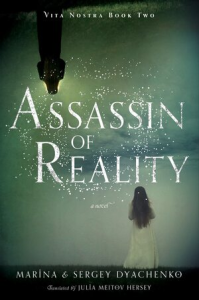
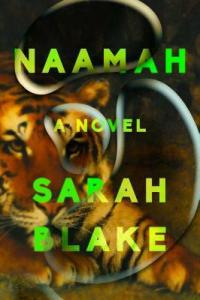


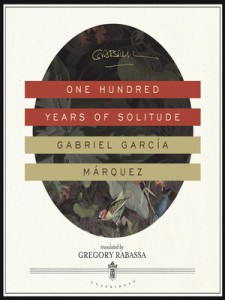

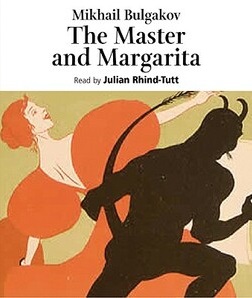

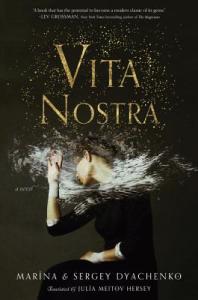

 Title: The Hearts We Sold
Title: The Hearts We Sold